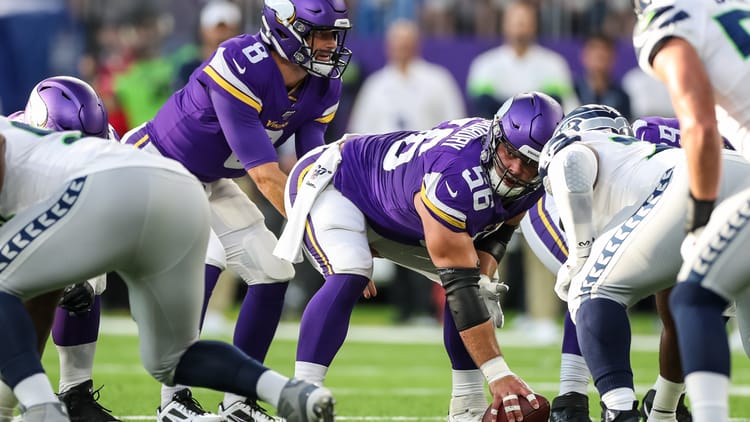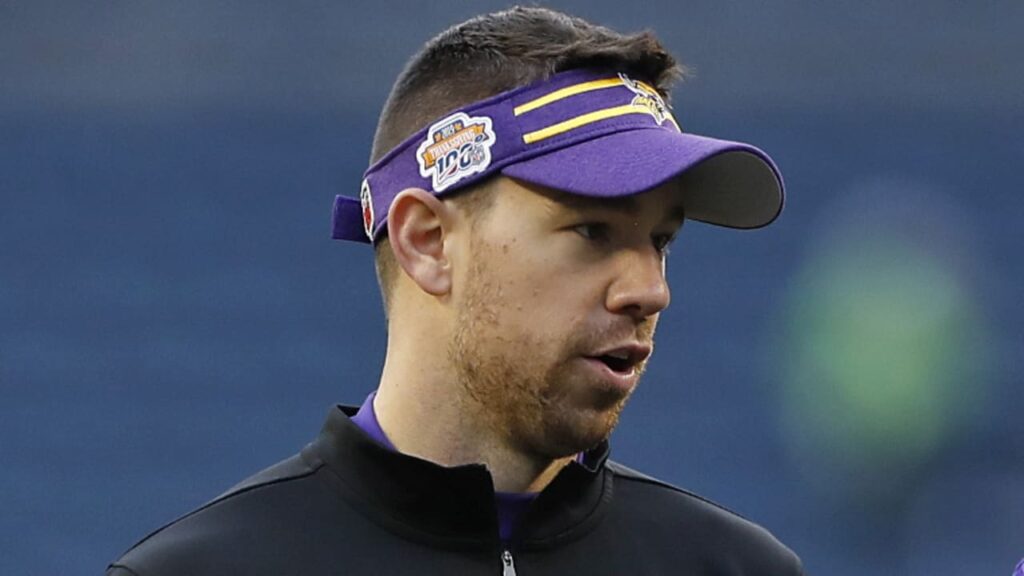Can the Vikings Offensive Line Keep Up with the Passing Attack?

The Vikings offensive line has not significantly improved its pass protection this season.
What has been better? Kirk Cousins.
The Vikings quarterback finished last season hot and continued that form into this season. His ability to recognize pressure and get the ball out rather than eat sacks when under pressure is noticeable.
Cousins has been sacked only 14 times through 10 games this season, compared to 39 games during 16 games last season. That’s a significant improvement, and on the surface — you’d think it means an improvement from the offensive line, but the interior looks as shaky as ever. And the pass protection is still poor.
Need a reminder of the frailty of the Vikings offensive line? Look at the play where Kirk Cousins was sacked and fumbled the ball against Green Bay. The Packers only rushed four, and three of them met at the quarterback.
Christian Darrisaw has the potential to be very good. Right now, though, he’s not as consistently good as Riley Reiff was last season. Reiff had an excellent final year in purple. Darrisaw has had some very nice highlights where he bullies defenders with his physicality.
As is the norm for the Vikings offensive line of this era, he excels in the run game. Pro Football Focus grades him a 70.6 run blocking, but only a 53.7 for pass blocking. There’s technical work to be done with his pass sets, evidenced by one particular play against Green Bay when he was put on his backside by the Packers backup edge rusher, Tyler Lancaster.
Ezra Cleveland saved that particular play. I’ve made no secret of my dislike of trying to turn tackles into guards. Cleveland has at least proved serviceable. Once again, it’s the run game where he’s made plays that stand out, like the huge hole he made for Dalvin Cook to walk into the end zone on Sunday. PFF scores him a reasonable 61.3 for run blocking and a much lower 51.3 for pass blocking.
Can Cleveland improve his pass protection and become the long-term answer at left guard? He has plenty of time to make his care, mainly because there are bigger issues to address with the other interior lineman positions.
Cleveland had nine starts at his new position last season, plus the ten so far this season. He seems to have settled into being an average starter who is capable of making significant blocks.
Perhaps Oli Udoh needs that amount of time, too? The third-year Viking instead surprisingly found himself in a new position on the Vikings offensive line.
Early in camp, he was the favorite option for right guard over rookie Wyatt Davis — another converted tackle like Cleveland has started all 10 games this season. It’s been a mixed bag for Udoh. In some games, he’s looked solid enough, whereas, in others, he’s looked really poor. PFF gives him a run-blocking grade of 66.3 and a pass-blocking grade of 50.1 — again, a respectable run-blocking grade, but the pass blocking isn’t good enough.
One big issue for Udoh is penalties, particularly holding.
He’s not the only culprit on the Vikings offensive line, but he is the worst offender, drawing 11 penalty flags this season, eight of which have been accepted, costing the offense 74 yards. Nine of those flags were for offensive holding, which is far too many for a starting guard. He needs to clean up that area of his game if he’s going to solidify himself as a long-term starter.
[brid autoplay=”true” video=”907478″ player=”26279″ title=”AdClipVT11%20VikingDv49O” duration=”158″ description=”undefined” uploaddate=”2021-11-24″ thumbnailurl=”//cdn.brid.tv/live/partners/19437/thumb/907478_t_1637786189.png” contentUrl=”//cdn.brid.tv/live/partners/19437/sd/907478.mp4″]
The center position is currently a conundrum for the Vikings, a former first-round pick Garrett Bradbury has been a disappointment. His recent spell on the Covid/Reserve list allowed Mason Cole to play two games. Cole did enough for people to want him to keep the job. (without being especially good himself). PFF gave him an impressive 72.1 grade for run blocking but a dreadful 30.3 for pass blocking. Cole looked decent in his first game, but he certainly had his hands full with Kenny Clark against Green Bay.
Garrett Bradbury’s PFF pass-blocking grade has been in the ’30s since coming into the league. Yet again this year, it is 38.7, compared to 61.9 for run blocking. Bradbury does everything a center needs to do well, except pass block. Unfortunately, he’s so bad in that area. And with no improvement into his third season, patience has run out among fans.
On the right side, Brian O Neill has become the stalwart of the offensive line. The one consistently reliable piece which has seen the cast beside him change over and over again. O’Neill is the outlier of the many draft picks made by the Vikings to solve their offensive line troubles. He is a rare breed for the Vikings in that his pass-blocking grade of 76.9 is higher than his run-blocking grade of 61.2, which has been the case for most of his Vikings career.
From day one, O Neill has simply been a good player for the Vikings. He checks in at an impressive fourth in the league with pressures allowed on just 2.57% of snaps.
Given a clean pocket, Kirk Cousins is as dangerous as any quarterback in the league. Sadly, a clean pocket for the Vikings doesn’t last long, if appearing at all. Klint Kubiak has done a reasonable job of scheming time for Cousins to throw in the last couple of games. Getting the play-action game going again has been important, moving away from the big bootlegs to the left that defenses were waiting for and pouncing on — to more subtle plays that did the job of buying Cousins some time.
As has been the case seemingly forever, how far this team can go hinges on how the Vikings offensive line can hold up against the good defenses with formidable pass rushers.
You can’t rely on Cousins making miracle throws under severe pressure to Thielen and Jefferson to make a miracle catch. As good as they are, the offensive line has to hold up their end of the bargain when the big games come down the stretch. That starts with Nick Bosa and Co. as the Vikings head to San Francisco this week for a game with huge playoff implications.


You must be logged in to post a comment.